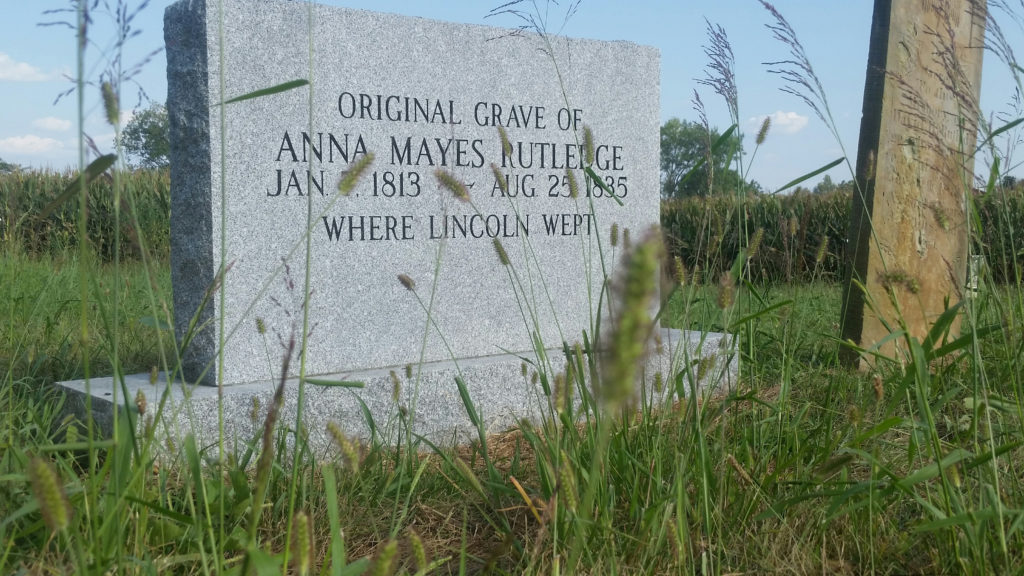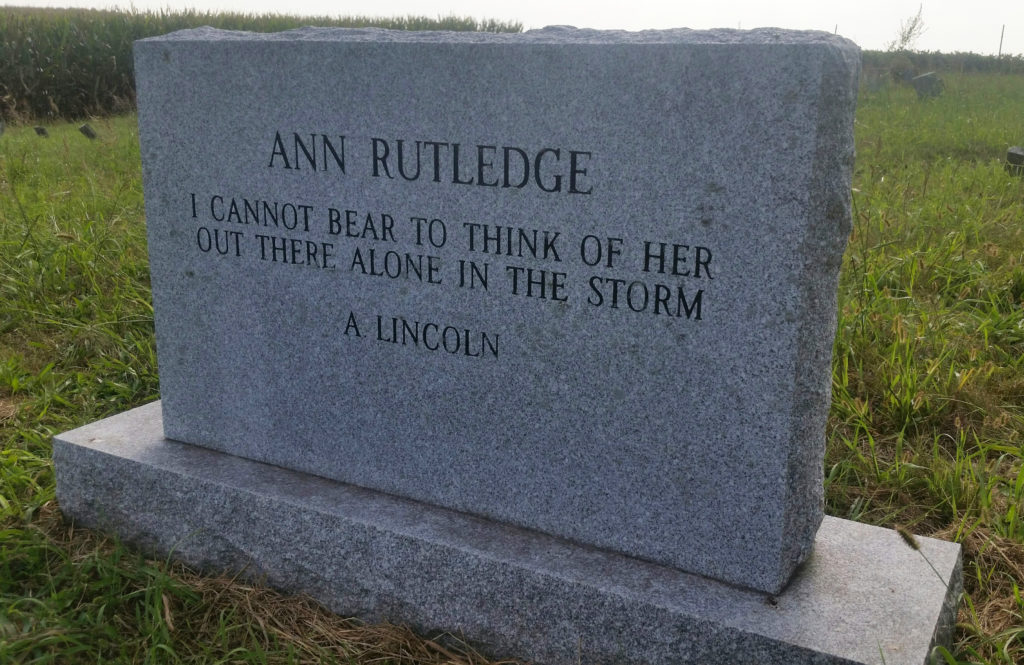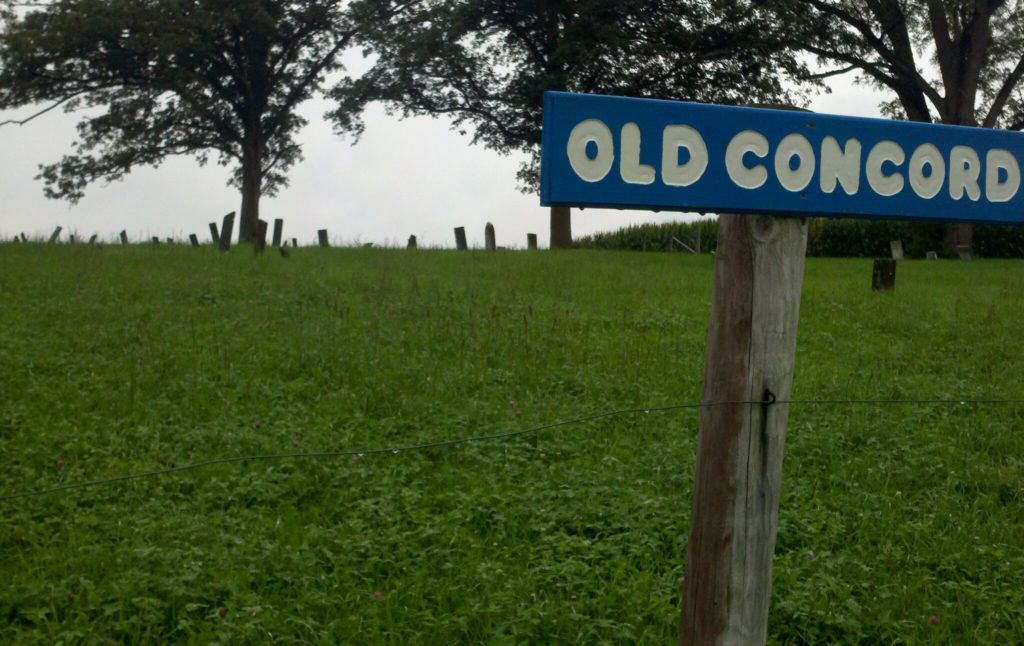 PETERSBURG, Ill. – It wasn’t like I stumbled upon a pot of gold, but it felt like it when, off in the distance, I saw a tattered American flag waving over a small clearing of farmland up on a hill between crops. As I crept closer, I could make out the silhouettes of small, tilted, weathered stones standing as well as they could after decades of duty. For years, I had been searching for the original gravesite of Ann Rutledge.
PETERSBURG, Ill. – It wasn’t like I stumbled upon a pot of gold, but it felt like it when, off in the distance, I saw a tattered American flag waving over a small clearing of farmland up on a hill between crops. As I crept closer, I could make out the silhouettes of small, tilted, weathered stones standing as well as they could after decades of duty. For years, I had been searching for the original gravesite of Ann Rutledge.
Rutledge, the pretty, auburn-haired, blue-eyed girl who caught Abraham Lincoln’s eye in the pioneer village of New Salem, Illinois in the 1830s, had always intrigued me. Many historians believe she was the first love of Abraham Lincoln, as I do. If you believe what Lincoln’s neighbors and friends wrote about the relationship, Lincoln deeply loved her and was exceptionally distraught when she died. She was just 22 when she took her final breath on August 25, 1835. On her deathbed, and probably suffering from typhoid fever, she summoned for Lincoln in her final hours. Lincoln came at once.
“I can never forget how sad and broken-hearted Lincoln looked when he came out of the room from the last interview with Annie,” Rutledge’s sister Nancy reportedly said. “No one knows what was said at that meeting, for they were alone together.”
Lincoln’s New Salem schoolmaster Mentor Graham, interviewed by Lincoln’s last law partner William Herndon after Lincoln’s death, offered a description of Rutledge.
“Weight about 120-130. Beautiful and ingenious, amiable, kind…exceptionally good scholar in all the common branches including grammar. She was beloved of everybody and she loved everybody.”
Graham continued…
“Lincoln and she both were studying at my house. Lincoln and she were engaged; Lincoln told me so, and she intimated to me the same. Lincoln told me he felt like committing suicide after her death but I know him of God’s higher purpose. He told me he thought so too, somehow…couldn’t tell how. He said my remarks and others’ had often done him good.”
An excerpt from Harvey Lee Ross, The Early Pioneers and Pioneer Events of the State of Illinois, reads…
“The deepest gloom and melancholy settled over his mind. He would often say to his friends, ‘My heart is buried in the grave with that dear girl.’ He would often go and sit by her grave and read a little pocket Testament he carried with him.”
 One of the most highly-respected biographies ever written on America’s 16th President by Lincoln scholar David Herbert Donald tells this story: After his election as president, an old friend, Isaac Cogdal, visited Lincoln. Cogdal, a quarryman and former New Salem resident, asked the president-elect if he had fallen in love with Ann. According to Cogdal, Lincoln replied, “It is true, true indeed I did. I loved the woman dearly and soundly. She was a handsome girl…would have made a good loving wife. I did honestly and truly love the girl and think often…often of her now.”
One of the most highly-respected biographies ever written on America’s 16th President by Lincoln scholar David Herbert Donald tells this story: After his election as president, an old friend, Isaac Cogdal, visited Lincoln. Cogdal, a quarryman and former New Salem resident, asked the president-elect if he had fallen in love with Ann. According to Cogdal, Lincoln replied, “It is true, true indeed I did. I loved the woman dearly and soundly. She was a handsome girl…would have made a good loving wife. I did honestly and truly love the girl and think often…often of her now.”
I first visited the gravesite of Ann Rutledge at Oakland Cemetery in Petersburg, Illinois some 40 years ago. But I soon learned that she was not originally buried at Oakland…that she was originally interred in Old Concord Cemetery, north of town. My decades of curiosity finally got the best of me and I soon found myself scouring cornfields in search of the original site.
And for years, I asked anyone in Petersburg who would take my question, “Where is the original grave of Ann Rutledge?” I even found someone who had been to the grave, but he couldn’t tell me exactly where it was other than about four miles north of town, off the main road by about three-quarters of a mile. He also finished with, “but you can’t get to it anymore…it’s surrounded by farm fields…fields of corn with no clear path to it anymore…and it’s on private property.”
Now I could have pounded on the front doors of farmers in the area, but I didn’t have the courage for that. Besides, it might blow my cover as they may not take kindly to some out-of-towner wandering through their property in search of dead people. Clearly, there were people out there who still knew where the site was, but, given the circumstances, I was on my own. So, every August, for four years, I took vacation days from work to wander through fields of corn in the direction I thought it might be, based on information I had gathered over the years. Getting lost among miles of endless corn, which is very easy to do I found out, was especially discomforting when darkness overcame my expedition one day/night.
I was just about to give up when, in late summer 2015, I decided to try one more time. This time, I didn’t go in as deep. I stopped at about a half-mile off the main road, turned right and found a path between crops, one that I had not previously been on. Then the path started to turn upward and to the right. Full-ahead I marched when, after about a mile in, a small clearing to my right uncovered itself. There was an American flag waving…that was a good sign. As I got closer, and with my heart racing, I could make out tiny, crooked stones standing on top of the hill. By now, I was at a full sprint to get there. I had struck gold…I had finally found the original gravesite of Lincoln’s sweetheart, and it was exhilarating. To my surprise, the cemetery was fairly-well kept, compliments of the local farmer who now owned the property. As an added bonus, I also discovered the graves of several of Lincoln’s New Salem neighbors and friends, people I had been reading about all my life, attached to Lincoln as they were.  People like Jack Armstrong, whose legendary wrestling match with Lincoln is still talked about today.
People like Jack Armstrong, whose legendary wrestling match with Lincoln is still talked about today.
As satisfying as it was to finally solve the mystery, the discovery spawned a new interest. Now I wanted to know when, and more importantly, why Rutledge was reinterred. To my relief, I was able to read my way through my newest mystery.
From an excerpt in a biography on Edgar Lee Masters (who wrote the epitaph on Rutledge’s gravestone at Oakland), I found this answer:
“An elderly relative of Ann Rutledge said it was a “greedy undertaker” who in 1890 first concocted the scheme of moving Ann’s remains from the Old Concord Cemetery, north of town, to the new cemetery on the south edge of Petersburg. More precisely, Oakland Cemetery promoter D. M Bone and his friend the undertaker Samual Montgomery decided it would be financially advantageous to move Rutledge’s remains. Montgomery and Bone seemed to feel that the new Oakland Cemetery could not compete with the nice Rose Cemetery (other side of town) unless it had a famous person interred therein. So on May 15, 1890, the undertaker and one of Ann’s relatives went to her grave in the Old Concord Cemetery. They opened the grave, dug down, and found nothing except “four pearl buttons,” which they moved along with some dirt to the new cemetery.”
 So…where are Rutledge’s remains? I’ll let you decide….
So…where are Rutledge’s remains? I’ll let you decide….
Note: In 1921, Petersburg municipal authorities had purchased an enormous gravestone and inscribed on it Masters’ epitaph for Rutledge from his most famous works: Spoon River Anthology. However, because it was widely believed that Rutledge really wasn’t “beneath these weeds,” it was considered fraudulent by many. However, nothing was done and the gravestone at Oakland remains to this day. Ironically, Masters is buried just a few yards away.
A portion of Rutledge’s Oakland gravestone reads, “I am Ann Rutledge who sleeps beneath these weeds, beloved of Abraham Lincoln, wedded to him, not through union, but through separation. Bloom forever o republic from the bust of my bosom.”
Masters will be the focus of an upcoming feature here at HistoryMysteryMan.com. Stand by…..
By Don Radebaugh
Additional Sources:
Herndon’s Informants, Edited by Douglas L. Wilson and Rodney O. Davis
Edgar Lee Masters, a Biography by Herbert K. Russell


no reason to doubt that they were enamored. Likely he was reluctant about Mary because she was more difficult and he had already he one bad experience.
Good point…thanks for sharing your thoughts. HMM
What do you think?
I have always loved Abraham Lincoln and regard him as our greatest president. God used him to save the Union and he gave his life for her.
Couldn’t agree more…thanks Arthur. HMM